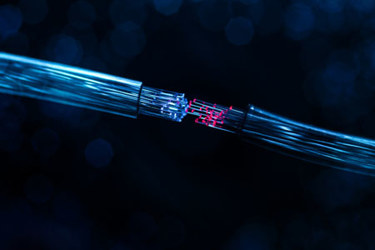Fiber Optics And Optical Interconnects: Powering Global Communications

By John Oncea, Editor

Fiber optics have revolutionized telecommunications, enabling high-speed, long-distance data transmission with unprecedented efficiency. Here, we explore this technology and its role in submarine cable systems.
Modern communication networks are built on fiber optic technology. At its core, an optical fiber consists of a glass or plastic core surrounded by a cladding material with a lower refractive index. This structure allows light to propagate through the fiber via total internal reflection, carrying data over long distances with minimal loss.
Among the numerous benefits provided by fiber optics are high bandwidth capacity, low signal attenuation, immunity to electromagnetic interference, and lightweight and compact design. But fiber optics need help to accomplish all of this and some of that help comes from optical interconnects, systems that use light to transmit data between components within a device or between devices.
Don’t Overlook Optical Interconnects
Optical interconnects are used to connect different parts of a fiber optic system and are a key part of the communication infrastructure. According to STL Tech, they use fiber optic cables to transmit data through light, which offers several advantages over traditional copper-based interconnects:
- Faster speeds: Optical interconnects can achieve higher speeds than copper-based interconnects.
- Longer distances: Optical interconnects can transmit data over longer distances than copper-based interconnects.
- Higher bandwidth: Optical interconnects can support higher bandwidths than copper-based interconnects.
- Immune to electromagnetic interference: Optical interconnects are immune to electromagnetic interference, which can degrade waveforms and cause signal interference in copper-based interconnects.
- Lower latency: Optical interconnects provide low-latency connectivity.
Optical interconnects are used in a variety of applications, including data centers, quantum computing, artificial intelligence, and 5G and future telecom networks. They can reduce the number of electronic components needed in edge servers and base stations.
Optical interconnects offer several benefits over traditional electrical interconnects, from higher data transmission rates to lower power consumption, and are used in integrated circuits, chip-to-chip communication, board-to-board connections, data center networks, and high-performance computing systems.
Fiber Optics In Submarine Cables
Submarine cables are the unsung heroes of global internet connectivity, carrying approximately 99% of intercontinental internet traffic. According to Data Centre Dynamics, these undersea fiber optic cables connect continents and countries, enabling high-speed data transmission across vast oceanic distances.
Submarine cables utilize specialized fiber optic technology optimized for long-distance, high-capacity data transmission:
- Fiber type: Submarine optical fibers typically use G.654 series fibers, which offer lower attenuation than common land-based fibers, according to Kentik. These fibers are optimized for use in the 1500-1600 nm wavelength range.
- Dense Wavelength Division Multiplexing (DWDM): This technology allows multiple data streams to be transmitted simultaneously over a single fiber, significantly increasing bandwidth capacity.
- Signal amplification: Optical amplifiers, also known as repeaters, are placed at intervals of about 70 km along the cable to boost the signal and maintain integrity over long distances.
Submarine cables are engineered to withstand the harsh oceanic environment. The fiber optic core is surrounded by layers of insulation and protection, including marine-grade polyethylene, steel strength members, and copper conductors.
The total diameter of a submarine cable is typically around 20-50 mm, depending on the level of protective armoring. Cables are buried under the seabed near the shore to protect against damage from anchors, fishing activities, and other marine operations.
Modern submarine cable systems offer impressive capacity and performance – for example, the Dunant cable between Virginia and France can transmit up to 250 terabits per second. Industry experts predict that petabit-scale systems crossing the Atlantic Ocean may be achievable within the next few years with ongoing research and development expected to push the boundaries of submarine cable capacity and efficiency.
Future Trends And Challenges
As the demand for global connectivity continues to grow, the fiber optics and optical interconnects industry faces several challenges and opportunities:
- Increasing capacity: Developing new technologies to further enhance data transmission rates and overall system capacity.
- Improving reliability: Enhancing cable durability and implementing redundant systems to ensure uninterrupted service.
- Reducing latency: Optimizing cable routes and signal processing to minimize transmission delays.
- Environmental considerations: Designing cables and deployment methods that minimize impact on marine ecosystems.
- Integration with emerging technologies: Exploring synergies with satellite communications and other complementary systems to provide comprehensive global coverage.
Fiber optics and optical interconnects play a crucial role in our interconnected world, with submarine cable systems serving as the backbone of global communications. As technology continues to advance, these systems will undoubtedly evolve to meet the ever-growing demand for faster, more dependable, and more expansive connectivity.
